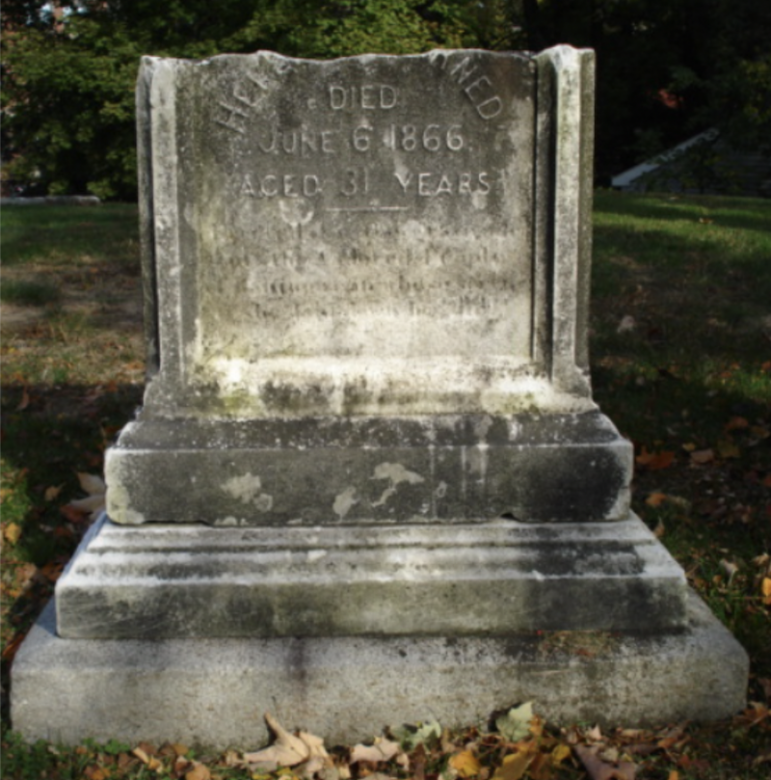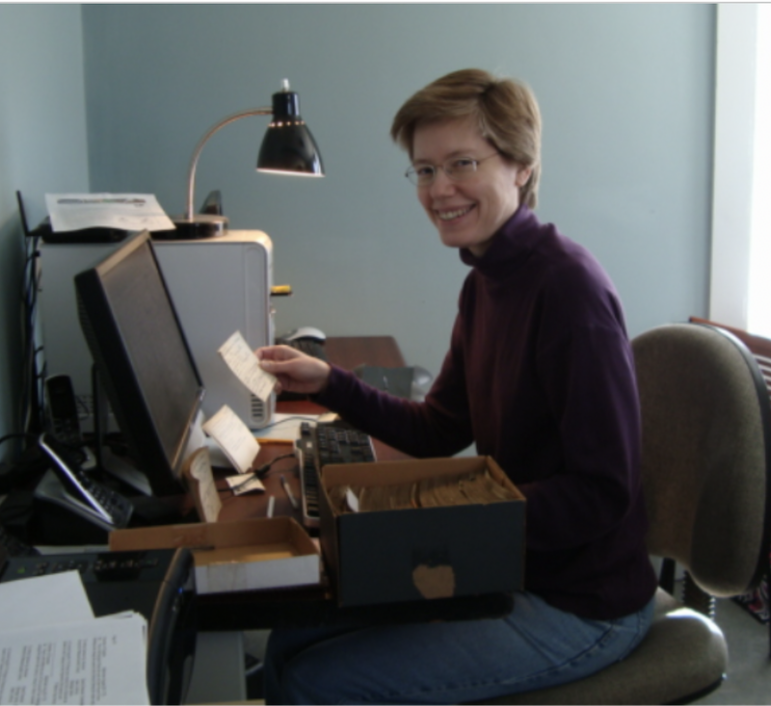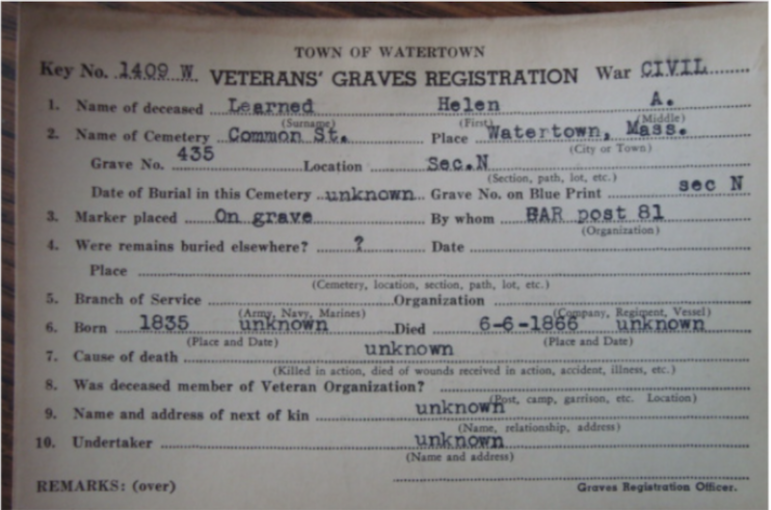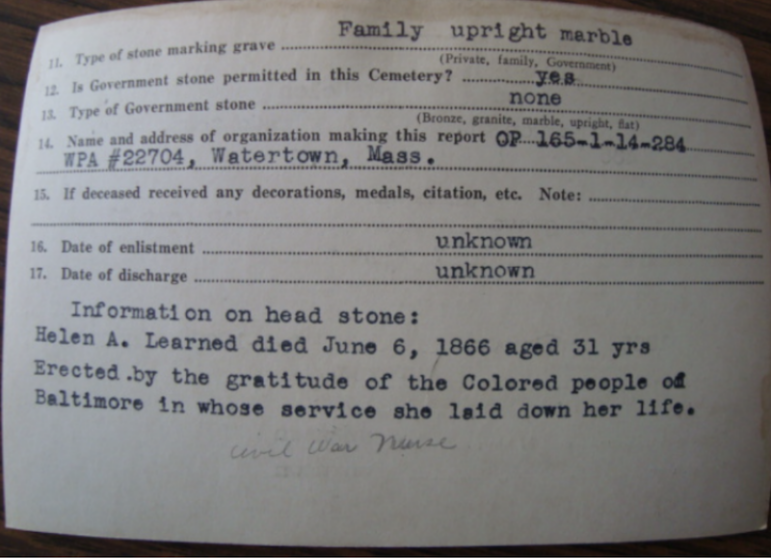
This article is part of a series on local history provided by the Historical Society of Watertown. It was written by Joyce Kelly, Board member of the Historical Society of Watertown. Joyce writes articles for the newsletter and is the newsletter editor. This was published in our April 2011 newsletter, “The Town Crier.”
In the early 1930s, the American Legion veteran’s organization launched an effort to identify the gravesite of every deceased veteran buried in the United States and create a permanent record. In 1933 the National Grave Registration Plan was adopted by the American Legion. The project got its start by depending almost entirely on volunteers including students, residents, veteran’s organization members and others, to gather information.
The project soon became a Works Progress Administration (WPA) program established under the Roosevelt Administration’s New Deal during the Great Depression. It was called the Graves Registration Project. Many projects were conducted under the WPA, which employed millions of Americans to work on public projects, including the construction of public buildings and roads.
Information for the Graves Registration Project was gathered from a variety of sources, including city and county public records, newspaper files, assessors’ books, church records, military records, veterans’ organizations, town histories, cemetery files, morticians’ records, gravestones, neighbors, friends and relatives, all over the country (some counties in some states did not
participate) and typed onto cards like the one depicted here.
When the Watertown American Legion Post 99 building closed in the 1990s they donated many items to the Historical Society, including the Veterans’ Grave Registration cards for Watertown. These cards hold a wealth of information. We recently began an effort to enter the information into a database to make it accessible to all.
Last year Historical Society volunteer Lynne O’Connell took on the project of creating an Excel spreadsheet using all of the data on the cards. They reveal a lot of information, though some of the cards are more complete than others. Many of the cards record “unknown” for Place of Birth,
Cause of Death, Next of Kin, and Enlistment and Discharge Dates.

The scope of time covered by these cards runs from the Colonial Wars (King Phillip’s War 1675–1676) to World War I, (1914–1918) but we know we do not have a complete inventory of all veterans buried in Watertown. We have 1,042 cards. Only five of them are from World War I. There are no cards for anyone buried in Sand Banks Cemetery (also referred to as Mount Auburn Catholic).
The cards have revealed some very interesting and important information. Gravestones deteriorate, become damaged from the weather, get vandalized, and sometimes simply sink into the earth. The cards, created almost 80 years ago, captured the words written on the gravestones that, in some cases, are no longer legible. For instance, Helen Learned’s stone in Common Street Cemetery is made of marble, a porous material that does not hold up well in the weather. The stone becomes “sugar-like,” wearing away until the letters upon it are no longer readable.
Helen Learned (1835–1866) was a Civil War nurse that we knew nothing about until reading her Grave Registration card. The words on her stone are worn away, in fact, her stone is broken and the top of it is missing. Her card tells us that the epitaph read, “Erected by the gratitude of the Colored people of Baltimore in whose service she laid down her life.“ Further research by Historical Society President Marilynne Roach revealed that after the war, Helen taught in a sewing school in Baltimore established by the Maryland Freedman’s Aid Society. Here she taught useful skills to now free African-American children.
Such Freedman’s Schools taught adults as well as children to read and thus attracted the resentment of many local whites. Another teacher, identified as M. S. Osborn wrote in 1865:
“Last week there was considerable agitation here about my work, and a meeting was held in which it was decided that I should leave the town. … I have no fear of rebels here, though they give me most unmistakable evidences that I am not wanted. One lady said if she were in my place, she would leave anyway, for not more than one person in 10 wanted me here. I thought, ‘I have not come to please the people, and I shall not leave to please them.’”
We don’t know yet what Helen experienced, but some of the schools were burned and the teachers run out of town. Helen came home and died at the age of only 31 of consumption.


As Lynne was working on this project, we were unaware that Bill McEvoy, a volunteer at Mount Auburn Cemetery, was working on a project to identify every Civil War soldier buried at Mount Auburn Cemetery, in preparation of the 150th anniversary of the beginning of the Civil War in April 1861. Mount Auburn Cemetery does not have a comprehensive listing of their interred veterans. Bill contacted the Massachusetts Adjutant General’s office in Worcester. He was informed that they had 20 rolls of microfilm from a Federal Works Progress Administration Project (WPA) that recorded veterans from the Colonial Wars to World War I who were buried in Massachusetts. A trip to Worcester revealed that the microfilm contained the names arranged alphabetically, A to Z. He would have to go through every name to find only the people that were buried at Mount Auburn.
He discovered that the top of every card showing a burial at Mount Auburn said “Town of Watertown.” He contacted us to see if we knew where he could find the original Watertown Grave Registration cards. We were thrilled to hear about his project and know that we could help him complete it.
Knowing that our collection of Veterans’ Grave Registration cards was not all-inclusive, Bill continued to make inquiries, trying to identify more veterans. He has added names to the listing of veterans buried in Watertown through inquires at the Watertown Free Public Library, Ancestry.com, the Harvard website, the Sons of Union Veterans website and other websites. He has added many of his findings to the www.FindaGrave.com website.
Our completed, searchable database, as well as Bill’s additions, will soon be added to our website. We will also offer it to the Public Library and the Town for their websites. Our hope it to make this information more easily accessible to researchers. (Note: The database was completed back in 2012. It is available on our website under the Resources page, and is downloadable.)
The Historical Society has since acquired additional Veterans’ Grave Cards from the Town, including WWI and WWII veterans and will be adding them to the current database.
Thank you, Joyce and Lynne.
As you are aware, the WPA survey overlooked the Catholic Mount Auburn Cemetery, however, I located 162
Veterans buried, or memorialized there:
152 Civil War
5 World War 1
3 World War II
2 during other eras
Two years ago, the Town of Watertown, Patrick George, provided me with permanent flag holders for the 120 graves that have markers. Each year he provides me with new flags, which I place in the holders.
Last Memorial Day I provided a new 25′ flagpole. It looks great.
The Watertown Veterans’ cadre renders honors at the flagpole on Memorial Day.
Hard to believe that it has been 12 years. I am still referring to the data.
I haven’t thought about this since 2011, but I recall that the Learned family lived at what is now Belmont Street, on the now Belmont side, down Grove Street to the present location of the Belmont Cemetery then back up to Belmont around Oxford Ave.
Before 1859 it was in Watertown. My Mother was born, in 1916, at 177 Belmont Street. I was raised there. The Learned homestead was on that property.